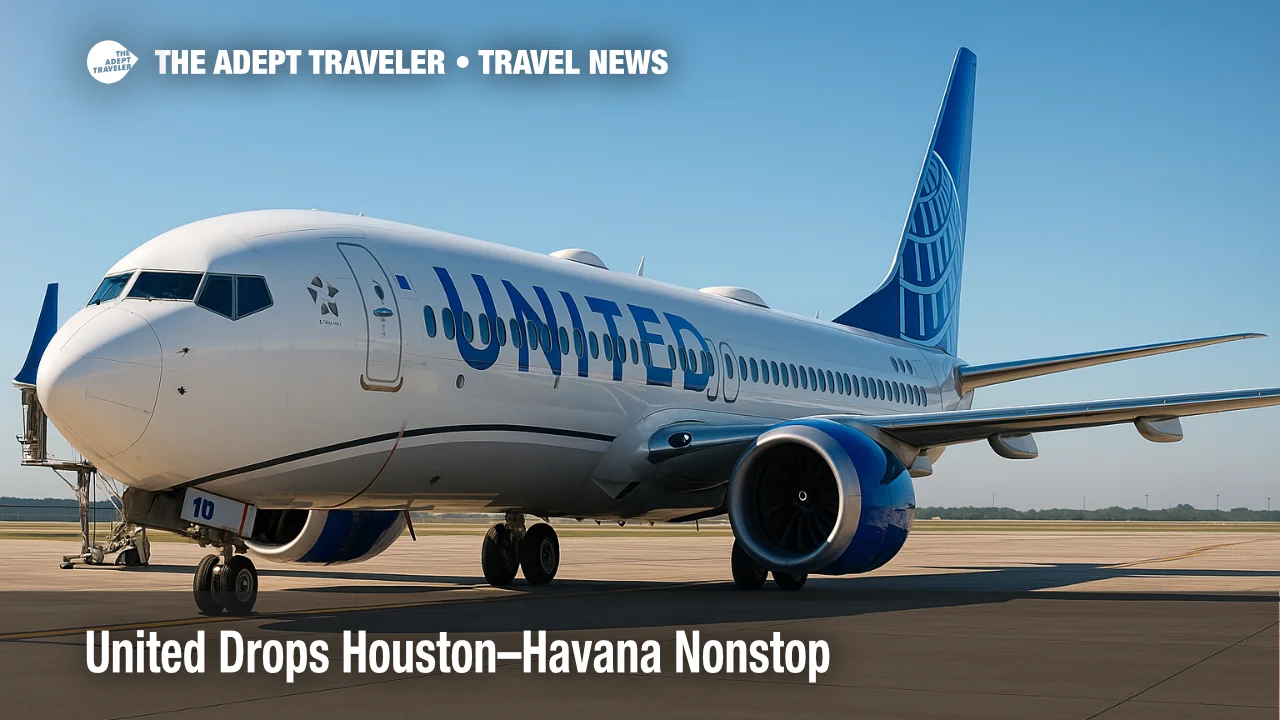United Drops Houston-Havana Nonstop: What Travelers Can Do

Houston-based travelers lost their shortcut to Cuba when United Airlines confirmed it will halt George Bush Intercontinental Airport (IAH)-José Martí International Airport (HAV) flights from September 2 through at least spring 2026. The move ends Texas's only nonstop to Havana, forcing passengers to connect elsewhere, navigate Cuba's strict entry procedures, and comply with U.S. Treasury rules that still prohibit pure tourism. Below, we map the smartest connection points-Miami, Panama City, and Cancun-and explain which U.S. travel-category licenses still apply.
Key Points
- Why it matters: Texas travelers must now add at least one stop to reach Cuba.
- Miami offers the fastest total journey thanks to up to 10 daily MIA-HAV flights.
- Copa Airlines' Panama City hub keeps itineraries on Star Alliance tickets.
- Cancun adds low-cost fares but involves Mexico's separate entry fees.
- U.S. visitors must still travel under one of 11 Treasury-approved categories.
Snapshot
United's daily Boeing 737 MAX 9 flight made Houston the only Texas city with a nonstop link to Havana. According to the carrier, "seasonal demand and market dynamics" prompted the pause, which blocks bookings past September 1. United will re-evaluate next summer. Southwest continues service from Ft. Lauderdale (FLL) and Tampa (TPA), while American and Delta dominate Miami-Havana. Travelers starting in Houston now face at least one connection, extra immigration stops, and higher costs-especially for last-minute bookings that avoid overnight layovers.
Background
Washington's 2019 clamp-down ended most U.S.-Cuba routes outside Havana and capped charter capacity. Although the Biden administration relaxed family-visit and remittance rules in 2022, the Office of Foreign Assets Control (OFAC) still bans leisure tourism. U.S. citizens must self-qualify under one of 11 general-license categories-most commonly "Support for the Cuban People," "Educational Activities," or "Journalistic Activity." Travelers must keep full-trip records for five years and use cash or non-U.S. cards on the island, since American payment networks remain blocked. Cuba also requires a tourist card, proof of medical insurance accepted locally, and an online health declaration within 72 hours of arrival.
Latest Developments
Miami: Quickest Turnaround
American Airlines runs up to eight daily nonstops from Miami International Airport (MIA) to Havana, with Delta adding two more. Typical flight time: 1 hour 15 minutes. United and American each fly IAH-MIA multiple times per day, making same-day connections straightforward. Total elapsed travel can be under six hours if schedules line up. Checked bags move through Miami, but passengers clear Cuban immigration only in Havana. Expect fares starting near $350 round-trip in shoulder season, rising sharply around U.S. holidays.
Panama City: Star Alliance Through-Ticket
For travelers loyal to United's MileagePlus, the Star Alliance pairing of United IAH-Panama City (PTY) and Copa Airlines PTY-HAV keeps the whole journey on a single record locator. United schedules two to three daily nonstops to PTY (≈4 hours 15 minutes). Copa offers at least one PTY-HAV flight most days, timed for midday or late-night connections. Same-day arrivals in Havana generally top eight hours gate-to-gate. Round-trip pricing often sits between $480 and $600, but award inventory is reliable in economy.
Cancun: Low-Cost Play-with Caveats
United, Spirit, and Southwest operate up to nine Houston-Cancun (CUN) flights daily, many under $300 round-trip. From Cancun, Mexican ultra-low-cost carrier Viva Aerobus runs thrice-weekly CUN-HAV service (1 hour 15 minutes) and sells walk-up tickets from about $125 one-way. This split-ticket approach lowers costs but adds complexity: travelers must clear Mexican immigration, purchase a Tourist Card (included in most airfares but not always when transiting), and re-check bags. Overnight layovers are common because CUN-HAV departures leave mid-morning.
Analysis
United's retreat underscores the fragility of U.S.-Cuba air links. Demand from Texas never matched Florida's Cuban-American base, and seasonal load factors likely slid below the carrier's financial threshold-especially with higher operating costs tied to the MAX 9 fleet. Miami's dominance stems from concentrated Cuban diaspora traffic and short stage length; American can profit on dense schedules even with OFAC limits. Panama City, meanwhile, serves as a strategic long-haul connector feeding South America and the U.S. Gulf Coast; Copa's ability to time banked waves keeps less-thick routes viable. Cancun exploits price-sensitive tourism: Canadians and Europeans leverage the same low-cost CUN-HAV links that Texans will now join, but the double-immigration shuffle and potential baggage re-fees diminish the savings.
For travelers intent on "Support for the Cuban People" itineraries, Miami remains the most reliable path, with backup frequency that cushions irregular-operation risks such as hurricane diversions. Star Alliance flyers chasing status or award seats should choose Panama City. Budget-minded passengers without tight schedules can gamble on Cancun-just remember Mexico's separate visa rules and the need to document qualifying activities in Cuba to satisfy American authorities.
Final Thoughts
United's suspension forces Texans to rethink Cuba plans, but robust Miami, Panama City, and Cancun links keep Havana within a single-connection reach. Verify your OFAC travel category, keep meticulous receipts, and build extra time for immigration as you map a new route to the Cuban capital. Staying compliant-and flexible-will turn this service loss into a manageable detour for Houston-area travelers eyeing the Houston-Havana nonstop's eventual return.
Sources
- United Airlines suspends Houston-Havana flights
- American Airlines: Miami - Havana schedule
- FlightConnections: MIA-HAV nonstop overview
- Copa Airlines: Panama City - Havana
- FlightConnections: PTY-HAV schedule
- FlightConnections: Houston - Cancun schedule
- Viva Aerobus: Cancun - Havana fares
- U.S. Treasury OFAC Cuba travel categories
